|
|
|||
|
It was just a matter of time this winter until we heard from our buddies Luanne and Buren Blankenship, who somehow seem to attract a vagrant hummingbird or two almost every year. We were due to be away from Hilton Pond over Thanksgiving and in Greenville SC--less than an hour from Columbus--so we laid plans to be at the Blankenships' on 26 November 2004. We were due for a special treat that day because Luanne's parents, the Caldwells (above left)--Faye (a master of gardening herself) and Dan (a most honorable survivor of battles at Iwo Jima during World War II)--were up from Hartwell GA to spend the Thanksgiving holiday.
#Y14858 in December 2003 (above left) and November 2004 All text & photos © Hilton Pond Center Since Blankenship birds always seem to show at the crack of dawn for first feeding, we arrived at 6:30 a.m.--before first light on the Columbus mountaintop. As always, we moved the Blankenship feeder into our portable trap and hung everything outside the dining room doors that look out over a patio crowded by Luanne's well-tended containers of Pineapple Sage, Turk's Turban, and various pitcher plants (the latter of which are not known to be hummingbird flowers).
#Y14858 in December 2003 (above) and November 2004 (below)
By 7 a.m. the hummer had made its first visit--barely visible in the pre-dawn light as it 'scoped out the trap and failed to enter. Three minutes later, however, hunger overcame hesitation and the bird flew directly into the trap. We hit the remote button and everyone was delighted as the sliding door closed. Even while in the trap the intense color of the bird's plumage indicated it was an adult, and its green back and incomplete metallic gorget indicated we had caught a female Rufous Hummingbird, Selasphorus rufus. In-the-hand there was no doubt--especially when we checked the bird's right foot and found a band. It was our old friend Y14858, banded in December 2003 at this very same spot.
#Y14858 in December 2003 (above left) and November 2004 Since this hummer was already an adult in 2003, we couldn't determine its exact age--then or now. According to Banding Lab protocol, we can only refer to it as an "after second year" bird, which means it hatched out not later than 2002. (By the way, the longevity record for a banded Rufous Hummingbird is eight years!)
#Y14858 in December 2003 (above) and November 2004 (below)
After banding and measuring the Blankenship's returning hummer, we photographed it, inserted its bill into a feeder for a few laps of sugar water, and handed it off to Luanne's parents for closer inspection. It calmly sat in everyone's hands for several minutes before zipping skyward into a nearby pine tree, after which Luanne laid out a fine breakfast--one of the added pleasures of visiting with her and Buren during winter hummingbird forays.
The day after our visit to Columbus on 26 November, Luanne reported that Y14858 returned to the feeder shortly after we departed AND that a second bird had put in an appearance on 27 November, so we suppose we'll be making another trip up Interstate 26 sometime soon.
All text & photos © Hilton Pond Center
If you're interested in sharing your hummingbird observations and learning from other enthusiasts, you may wish to subscribe to Hummingbird Hobnob, our Yahoo!-based discussion group. Also be sure to visit our award-winning Web site for Operation RubyThroat: The Hummingbird Project; on it you'll find almost anything you want to know about hummingbirds, including more information about Hummingbird Banding.
For much more information about hummingbirds, visit Operation RubyThroat: The Hummingbird Project 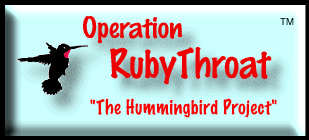 |
|
Make direct donations on-line through
Network for Good: |
|
|
LIKE TO SHOP ON-LINE?
Donate a portion of your purchase price from 500+ top on-line stores via iGive: |
|
|
Use your PayPal account
to make direct donations: |
|
 post questions for The Piedmont Naturalist |
Join the |
Search Engine for |
|
|

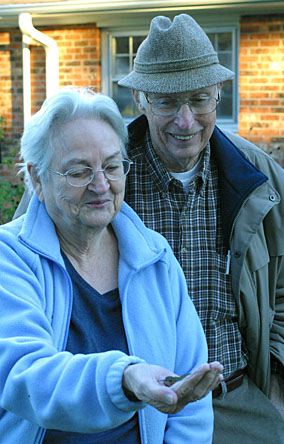 They had a
They had a 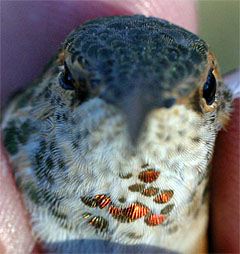 ...
...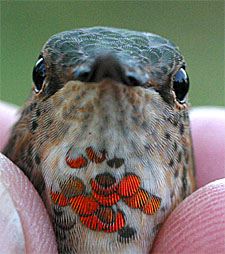
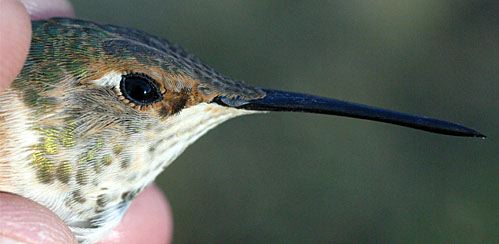
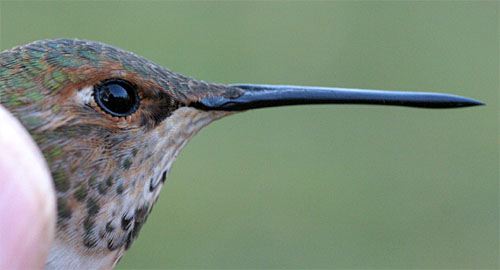
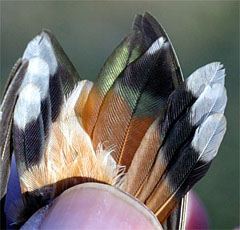 .
.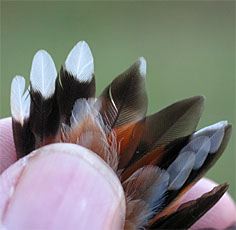


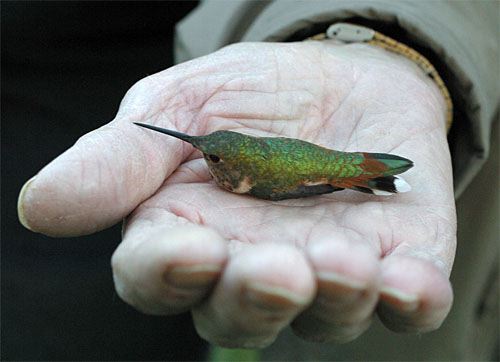
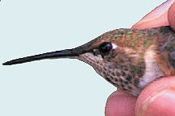
 Students at GLOBE-certified schools may submit winter hummingbird observations as part of Operation RubyThroat and GLOBE. Students can also correlate hummingbird observations with data on abiotic factors, including atmosphere, climate, hydrology, soils, land cover, and phenology. See the
Students at GLOBE-certified schools may submit winter hummingbird observations as part of Operation RubyThroat and GLOBE. Students can also correlate hummingbird observations with data on abiotic factors, including atmosphere, climate, hydrology, soils, land cover, and phenology. See the 

